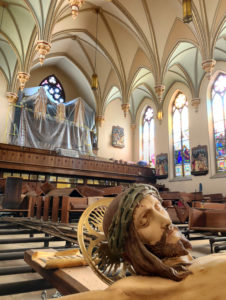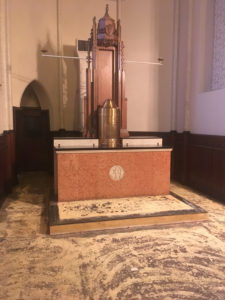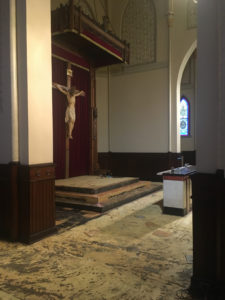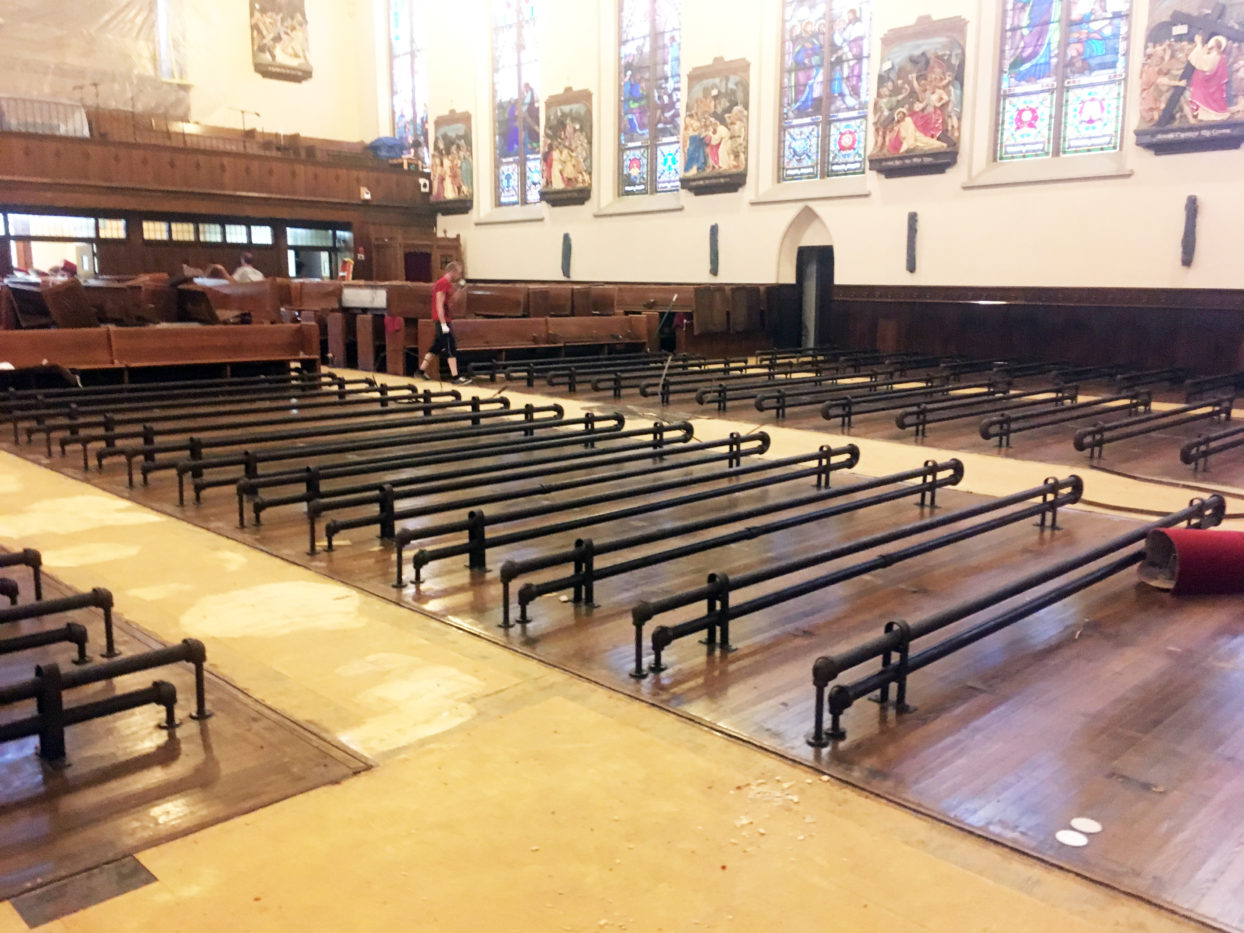Renovation of Basilica of Sts. Peter and Paul yields unexpected (and valuable) links to the past
By Bill Brewer
When you renovate something that is 125 years old, you’re bound to have a few surprises.
Restoration work inside the Basilica of Sts. Peter and Paul has revealed details of original church construction that have been hidden since the 1930s – details that greatly enhance the basilica’s architectural authenticity and even help its financial value.
 Construction began in July to remodel the sanctuary and vestibule, and once workers began doing initial demolition, they unexpectedly interrupted progress, according to Father David Carter, rector of the basilica.
Construction began in July to remodel the sanctuary and vestibule, and once workers began doing initial demolition, they unexpectedly interrupted progress, according to Father David Carter, rector of the basilica.
“Just like with any old building, you have unexpected things that come up. We’ve had a few surprises that were frustrating, but also a few surprises that are exciting,” Father Carter said.
The present church building in downtown Chattanooga was dedicated in 1890, making it the second oldest in the Diocese of Knoxville, although the basilica parish is the oldest in the diocese.
Father Carter explained that some remodeling of the church took place in 1936, when part of the original church was covered up.
“When we pulled up the carpet and vinyl tile, we were curious because we saw a thin-set layer of concrete, and we noticed there was wood flooring underneath,” Father Carter said. “We found the original 1890 heart pine floor in the nave, which we have decided to refinish and restore to its original glory.”
According to Father Carter, heart pine was a commonly used material in construction back then, but now it’s considered a precious commodity that is sought out at great expense. “It is considered luxurious by some because it is nearly impossible to find in the wild now. We had it underneath our carpet and tile the entire time.”
 The church’s original exterior façade was redone in 1936 because of crumbling infrastructure, and the vestibule space was created. At that point, certain spaces were covered over, according to Father Carter.
The church’s original exterior façade was redone in 1936 because of crumbling infrastructure, and the vestibule space was created. At that point, certain spaces were covered over, according to Father Carter.
“In the course of reviewing plans from 1963 and inspecting the church, we noticed empty space behind a wall. Our curiosity got the better of us, and we decided to explore those spaces. We found two alcoves with vaulted ceilings that add considerable space to our otherwise cramped vestibule,” he said. “The restoration of the original interior of the church is what we’re going for. We’re highlighting original themes.”
Included in the scope of work are new altars made of finely carved wood instead of retrofitted marble altars installed in the 1930s. The basilica rector said the original Sts. Peter and Paul altars were carved in the High Gothic style and were taken down because they were eaten by termites.
Father Carter said termite traps have been installed, so altars eaten by pests will no longer be a problem.
A woodworking family in Kentucky is hand-carving the altars based on drawings in keeping with the original church motif. Architect James McCrery, who designed the Cathedral of the Most Sacred Heart of Jesus, provided the new drawings.
 The renovation project is part of the 125th anniversary of Sts. Peter and Paul, which was celebrated in 2015. Basilica parishioners have raised the money for renovation through the Home Campaign and have been excited about the project getting underway. Donations from outside the parish have also contributed to the fundraising effort.
The renovation project is part of the 125th anniversary of Sts. Peter and Paul, which was celebrated in 2015. Basilica parishioners have raised the money for renovation through the Home Campaign and have been excited about the project getting underway. Donations from outside the parish have also contributed to the fundraising effort.
Total cost of the project is $450,000.
During the six months of construction, all Masses are being celebrated in the Varallo Parish Hall downstairs from the sanctuary. Father Carter hopes the project is completed by December, but more surprises could prompt delays. Bishop Richard F. Stika will dedicate the newly refurbished basilica.
Besides inconvenience, Father Carter said there has been some frustration with scheduling delays.
“We’re in exile in Varallo Hall. But Varallo Hall has served us well. It has kind of a catacomb feel. It’s more of an intimate experience than the grandeur above.”
He pointed out that the church’s electrical wiring had not been updated since the 1930s and that all plugs were ungrounded.
“It was supposed to be a simple project, but unexpected discoveries have added to the scope of things,” Father Carter said. “It became a safety issue. We’ve included fi re safety equipment as part of this project.”
Father Carter, who has served as basilica rector since 2013, believes this is the first major renovation of the church since 1936. He explained that soon after arriving at the basilica, he and parishioners held a town hall meeting to determine the hopes and dreams of parishioners and the future of the parish.
Renovation work had already occurred on the basilica’s nursery and rectory.
“The No. 1 desire among the faithful was a renovation of the church sanctuary, in particular moving the tabernacle to a central place of honor and restoring the altar rail as well as changing the flooring from carpet to something more durable. We have been planning ever since to incorporate these changes,” Father Carter said.
“We’re now able to fulfill the promise of a new sanctuary. We believe one of our roles is to show forth the apostolate of beauty. Beauty speaks to the heart of every human being, and it often is a great opening to the Gospel message. Beauty itself is a great evangelizer,” he noted.

